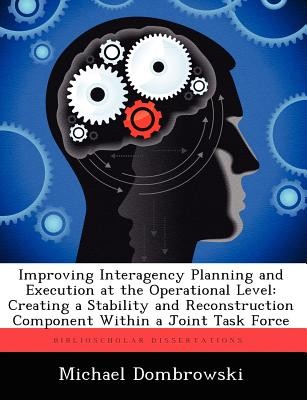
- We will send in 10–14 business days.
- Author: Michael Dombrowski
- Publisher: BiblioScholar
- ISBN-10: 1249368383
- ISBN-13: 9781249368380
- Format: 18.9 x 24.6 x 0.7 cm, softcover
- Language: English
- SAVE -10% with code: EXTRA
Improving Interagency Planning and Execution at the Operational Level (e-book) (used book) | bookbook.eu
Reviews
Description
Over the past fifteen years, many have argued that the military's overwhelming battlefield successes stem from the Goldwater-Nichols Defense Reformation Act of 1986. While few can debate the efficacy of joint US military operations in a high-intensity conflict, many still debate the effectiveness of the interagency community's attempts at winning the peace. Recent operations in Afghanistan and Iraq illustrate the lack of interagency unity of effort at the operational level and cry out for an enduring solution similar to Goldwater-Nichols. This thesis explores three distinct courses of action for improving operational interagency unity of effort and presents a cogent argument for creating a new component within a joint task force to address all stability and reconstruction tasks. This stability and reconstruction component would capitalize on the momentum gained by the State Department's Office of the Coordinator for Reconstruction and Stability Operations (S/CRS) and utilize resources already in place or expected to be in place to support S/CRS' Advance Civilian Team concept. The component would be led by a civilian interagency representative and be staffed by both military personnel and interagency representatives pulled from S/CRS' Active Response Corps (ARC).
EXTRA 10 % discount with code: EXTRA
The promotion ends in 16d.13:19:41
The discount code is valid when purchasing from 10 €. Discounts do not stack.
- Author: Michael Dombrowski
- Publisher: BiblioScholar
- ISBN-10: 1249368383
- ISBN-13: 9781249368380
- Format: 18.9 x 24.6 x 0.7 cm, softcover
- Language: English English
Over the past fifteen years, many have argued that the military's overwhelming battlefield successes stem from the Goldwater-Nichols Defense Reformation Act of 1986. While few can debate the efficacy of joint US military operations in a high-intensity conflict, many still debate the effectiveness of the interagency community's attempts at winning the peace. Recent operations in Afghanistan and Iraq illustrate the lack of interagency unity of effort at the operational level and cry out for an enduring solution similar to Goldwater-Nichols. This thesis explores three distinct courses of action for improving operational interagency unity of effort and presents a cogent argument for creating a new component within a joint task force to address all stability and reconstruction tasks. This stability and reconstruction component would capitalize on the momentum gained by the State Department's Office of the Coordinator for Reconstruction and Stability Operations (S/CRS) and utilize resources already in place or expected to be in place to support S/CRS' Advance Civilian Team concept. The component would be led by a civilian interagency representative and be staffed by both military personnel and interagency representatives pulled from S/CRS' Active Response Corps (ARC).


Reviews